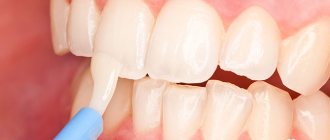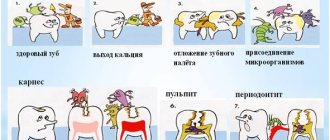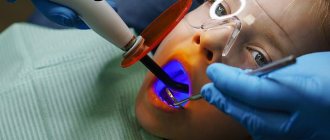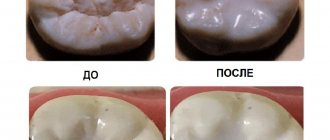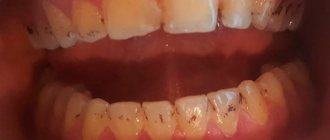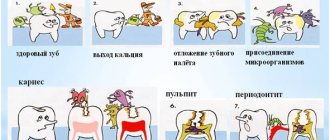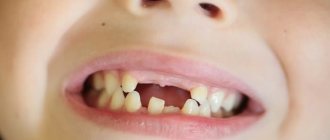Fissures are grooves on the surface of the chewing teeth. The problem is that they contain food residues, which are quite difficult to completely remove at home. As a result, the pits and grooves expand, which leads to the formation of a special type of caries - fissure caries.
To avoid such problems, you can perform “sealing” or sealing of the fissures. This procedure serves as an effective method of preventing caries, especially in children. For detailed information, make an appointment with our specialists.
In what cases is fissure sealing prescribed and why?
To prevent premature tooth decay in the fissure area, dentists recommend sealing. This method allows you to reliably close vulnerable areas, thereby ensuring their protection from the effects of bacteria. Thus, the enamel in the grooves has time to mature and strengthen, after which it becomes less susceptible to caries.
It is important to remember that the first fissure lesions can occur immediately after the eruption of permanent teeth. If their enamel is not strong enough, caries may appear during the first year of tooth growth. Therefore, it is better not to delay sealing.
Dentist advice
Osmanov Konstantin Gennadievich
Sealing can only be done on the front part of the teeth. All other surfaces remain just as vulnerable to caries. Therefore, it is important to remember that after the procedure you should not neglect proper oral care.
Dental fissure sealing – what is it?
Fissure sealing is a very simple and painless procedure. It consists of applying a certain substance to the side tooth, which reliably covers the grooves and protects them from the harmful effects of bacteria.
It often takes no more than 5 minutes to seal one tooth. In this case, the patient does not feel any discomfort. The effect of the procedure lasts for five or more years. As practice shows, patients who have undergone sealing are much less likely to have problems with the appearance of caries on fissures, even after 10-20 or more years.
Reviews
Practice shows that timely prevention is the most effective way to reduce the incidence of dental diseases. This is evidenced by the reviews of our patients.
Thank you for choosing Natadent clinic and coming back to us again.
LEAVE FEEDBACK
Modern methods of carrying out the procedure
The technique for sealing fissures is quite simple. If all the necessary materials are available, any dentist can perform it. However, depending on the condition of the teeth, the procedure algorithm may be different.
Invasive sealing
In cases where the fissures of the tooth are very narrow or deep, or caries has already begun to develop in them or nearby, the doctor carries out invasive sealing. It begins with sanding, which allows access to the entire surface of the fissures for thorough cleaning and coating with sealant. Also, shallow carious lesions (up to 2 mm) are removed from the fissure.
If the fissure lesions are more serious and the caries has spread to large areas, the doctor carries out standard treatment before sealing. Only after this can he begin to seal the fissures. This is done to prevent the possibility of tooth decay developing under the hardened material.
Non-invasive technique
A non-invasive procedure is carried out when the tooth is completely healthy and its fissures do not even have superficial lesions. In this case, they are simply cleaned well, disinfected and a sealant is applied.
What are fissures?
Fissures are natural grooves and grooves located on the chewing surface of the teeth between the cusps. The shape and size of fissures, as well as their location, make it difficult to brush teeth, and accordingly, food debris can get stuck in these places, contributing to the development of pathogenic bacteria. In addition, the layer of tooth enamel in these areas is quite thin, which also contributes to the development of caries.
There are 4 types of fissure structure:
- Funnel-shaped (fluted). Shallow and fairly open mouths, smooth sloping walls with dense enamel. This shape promotes natural cleansing of fissures and facilitates their mechanical cleaning. In funnel-shaped fissures, a process of natural sealing with mineralized deposits often occurs. Caries occurs least often in them.
- Cone-shaped. The walls are located quite close, forming a cone at the mouth that is difficult to access for mechanical cleaning. Fluid is retained in such fissures, causing the enamel to be poorly mineralized, remaining porous and vulnerable to bacteria. To avoid caries, very thorough teeth cleaning is necessary.
- Flask-shaped or teardrop-shaped. The teardrop shape of the vaults makes self-cleaning impossible and makes mechanical cleaning extremely difficult. Liquid and food debris accumulate at the bases of the fissures, which ultimately often leads to caries.
- Polypoid. The shape resembles a teardrop, the walls are uneven, with protrusions. This is the type of fissure most susceptible to caries.
Features of using the technique for children and adults
Typically, fissure sealing is carried out in childhood, when permanent teeth are just beginning to grow. This can significantly reduce the likelihood of developing caries in the next 5-10 or even more years. The optimal time for the first procedure is the age of 6-7 years, when the first molars finish erupting. The next procedure can be performed as early as 8-9 years. It is during this period that the first permanent premolars erupt. The third stage is the age of 12-13 years, when the second permanent molars grow, which means the completion of the formation of the children's permanent dentition.
However, in certain cases, fissure sealing may also be recommended for adults. Despite the fact that the enamel in these areas of the tooth has already been formed, for a number of reasons it can become depleted, wear out, etc. If this happens, and the patient is worried about an increased likelihood of developing caries, he can resort to a fissure sealing procedure at any age.
Arguments for and against fissure sealing in childhood
The attitude towards sealing among doctors and patients is overwhelmingly positive. This procedure is carried out quickly and does not cause any discomfort, so even the youngest visitors to the dental office will not be afraid to perform it.
However, it is important to remember that the technology for carrying it out has a clearly established algorithm. And if an inexperienced doctor does not follow it, this is fraught with deterioration in the condition of the teeth - the beginning of the development of caries under the hardened sealant. Due to the fact that the surface of the fissures will become closed after the procedure, this process can easily be missed.
When are children's teeth sealed?
The procedure is most effective at a time when children's teeth are not yet affected by caries. If the teeth have very deep and complex fissures, then almost immediately after eruption they begin to fill with microorganisms and food debris, after which caries develops very quickly, followed by tooth decay. Therefore, it is best to do the procedure immediately after the molars erupt. Typically, the first permanent molars appear at the age of 6-8 years, and the second - at 12-14 years. Immediately after their complete eruption, we can say that it is time to do this procedure.
Manipulations can also be performed on baby teeth. Even small children tolerate them well.
What is the procedure for sealing teeth in children?
Before the procedure, you need to visit a dentist for a consultation on how exactly to seal your child’s teeth and whether it is absolutely necessary to do this. The doctor will conduct a thorough examination and evaluate the positive effect of such manipulations, determine the exact cost of the procedure and materials needed in your case.
The procedure itself is absolutely painless, but both local and injection anesthesia are possible. In newly erupted teeth, the fissures are very narrow, soft and deep due to incompletely formed enamel, which contains much less essential minerals. This almost guarantees that by the time you visit the dentist, certain food debris has already accumulated in them and will need to be removed. The procedure is performed with special equipment.
After cleaning, the tooth is filled with a sealant - a self-hardening sealant that fills empty spaces, hardens and thus prevents the penetration of microorganisms and food debris into them. In addition, the tooth becomes much easier to clean, which creates additional protection.
After cleaning the tooth with all necessary means, the dentist clears the oral cavity of saliva using special rollers and equipment. A special composition is applied to the tooth to facilitate the adhesion of the sealant to the surface, after which the tooth is dried and the sealant itself is applied to it. Due to its fluidity, it is perfectly distributed over the entire surface of the tooth, filling even the narrowest and deepest fissures and making the tooth completely protected from harmful factors.
After the sealant has completely filled the grooves, the dentist uses a special lamp to cure it, or waits a while when using a self-curing agent. The main thing after hardening is the absence of discomfort when closing the jaws. The doctor checks this with special paper and, in the case of too much material, removes it with special rotating devices, which is also absolutely painless. After completing the entire procedure, the tooth is coated with a special varnish or gel.
Sealants can be different both in their properties and in cost. They often contain fluoride to better strengthen tooth enamel, so in addition to the barrier value, the procedure also has hygienic and preventive purposes.
Which fissures need to be “sealed”?
The thinnest and deepest. After all, the thinner and deeper the fissure, the more difficult it is to clean; the most difficult ones are not cleaned at all. In addition, the sealant penetrates best into thin and deep “pits”, therefore, the thinner and deeper the area being filled, the more successful and useful the procedure.
All this applies to the posterior chewing teeth, since they usually have the narrowest and deepest “grooves.” Such teeth require the creation of a barrier that will protect them from the adverse effects of microorganisms, acids and the environment.
Only the dentist himself can determine what needs to be sealed and what is optional. He conducts an examination to identify deep fissures.
Do all fissures in children need to be sealed?
There are fissures on all posterior chewing teeth. However, not all of them are pronounced; there are also open fissures that can be easily cleaned with a toothbrush, and there is no need to carry out this procedure on them. Still, sealing teeth in children is an intervention and if it is not required, you should not do it just like that.
However, if at the time of preparation for sealing caries has already appeared inside the fissures or on the teeth themselves, then it is necessary to carefully get rid of it by sanding the affected areas and treating these places with a special compound.
How long will the effect of the procedure last?
For about two to three years, the sealant will reliably protect the child’s teeth from microorganisms. However, it is necessary to see a dentist twice a year to monitor the condition of teeth in general and sealed baby or permanent teeth in particular. In general, as practice shows, even after 5-10 years, the sealant completely protects the tooth from acids and caries.
It is considered that the procedure was carried out correctly and successfully if the sealant on the tooth has been preserved well for 3-5 years. However, even if it lasted less, it is necessary to remember that protecting the tooth from caries all this time was worth it.
Reviews about sealing teeth in children
At the moment, reviews from both doctors and patients indicate that sealing baby and permanent teeth in children is a procedure that, with almost complete absence of negative aspects, is exceptionally effective in protecting the posterior chewing teeth from caries and destruction. This is exactly the case when, with a correctly performed sealing procedure for both primary and permanent teeth in children, everyone remains satisfied: doctors, parents, and young patients.
To keep your teeth healthy even longer, use the right toothpastes. Asepta products from the Baby, Kids and Teens series will protect and strengthen the enamel, keeping teeth snow-white and strong. They are designed taking into account age-related needs, replenish the lack of minerals in the enamel, and protect the oral cavity from acids. At the same time, our pastes have a pleasant taste that children like!
Take care of your family with Asepta!
Materials for fissure sealing
The sealing procedure is carried out using liquid flowable materials called sealants. They quickly spread over the surface of the teeth in the fissure area, filling all the smallest recesses. They contain fluorine, which provides additional strengthening and nutrition to the enamel during the sealing period. Sealants belong to the category of light-curing materials, due to which, after application, they are able to harden within 40 seconds under the influence of a special lamp.
The color of the fissure sealant can be completely different. Teens and adults can choose a clear material or one of the white ones that will best match the shade of the surface of the teeth. For small children, multi-colored options are provided - pink, blue, etc.
Fissure sealing technique
Sealing is carried out according to a certain algorithm:
- first, the doctor thoroughly cleans the tooth surface using fluoride-free paste;
- Next, the fissure is treated with an antiseptic and cotton rolls are installed;
- for better disinfection, the tooth is treated with a special acid, which is subsequently washed off;
- After thoroughly drying the fissure, sealant is applied;
- it is fixed using a lamp;
- the excess is sanded off;
- the surface is coated with a special varnish for greater fixation.
If all steps are carried out correctly, the tooth will remain hermetically sealed for 4-5 years. After this, if necessary, the procedure can be repeated.
Recommendations after the procedure
In order for the sealant to last as long as possible, you should follow the following care recommendations:
- In the first 3-4 hours after applying the sealant, you must refrain from eating so as not to compromise the integrity of the material.
- For the first two days, do not eat solid food, so as not to damage the sealant.
- Carry out hygiene using a soft toothbrush and toothpastes without abrasive particles.
- Do not use an electric toothbrush. This is due to the fact that the high speed of rotation of the bristles negatively affects the structure of the sealant.
- When brushing your teeth, do not press too hard on the chewing surface of your teeth.
Compliance with these recommendations ensures the integrity of the sealant for 5-7 years.
Indications and restrictions for the procedure
The main indication for the procedure is the completion of the eruption of permanent teeth. Since fissure sealing is one of the most effective methods of caries prevention, you should not delay it. If this time has been missed, but the process of damage has not yet begun on the teeth, fissure sealing can be done at any other age.
In addition, it is important to pay attention to the condition of the surface of molars and premolars. If pigment spots or small depressions begin to appear in the area of their fissures, this is a direct indication for the procedure.
As for restrictions, there are not many of them. The main one is severe damage to teeth by caries. Also, the procedure may be refused if the patient has allergic reactions to certain materials used.
Indications
The ideal period for sealing the fissures of baby teeth is up to 3 months after tooth eruption. During this time, the furrows do not have time to fill with deposits, which become more and more difficult to remove every month.
During the examination, the doctor determines the indications for sealing the fissures of baby teeth if he sees a number of factors:
- complex shape of fissures,
- absence of caries on the tooth in question,
- the presence of pigmentation in the form of chalky spots - a symptom of enamel demineralization and the first harbinger of caries,
- “age” of the tooth is up to 4 years,
- presence of caries on other teeth,
- poor oral hygiene.
Cost of fissure sealing
Since the procedure is non-invasive or minimally invasive and takes no more than a few minutes, the cost will also be low. Typically, you need to pay 2-3 times less for sealing one fissure than for treatment in the presence of caries.
However, the cost of the procedure may vary depending on the characteristics of the materials used, as well as the condition of the dentition. Therefore, the price must be clarified in each specific case.
The iOrtho clinic network provides high-quality services for correcting malocclusion with Invisalign aligners, sign up for a consultation now!
Preventive actions
To ensure that caries does not bother you for many years, you must take the following preventive actions:
- Buy toothpastes containing calcium and fluoride. Parents can brush their children's teeth with toothpaste from the age of 2, and before that they should simply wipe their teeth with fingertips.
- From the age of 3 you can already use children's electric toothbrushes.
- You need to brush your teeth 2 times a day: in the morning after meals and in the evening before bed.
- When using a manual toothbrush, you need to brush your teeth correctly: the movements should only be “sweeping” - from the gum to the tooth, the toothbrush is positioned at an angle of 45 degrees.

